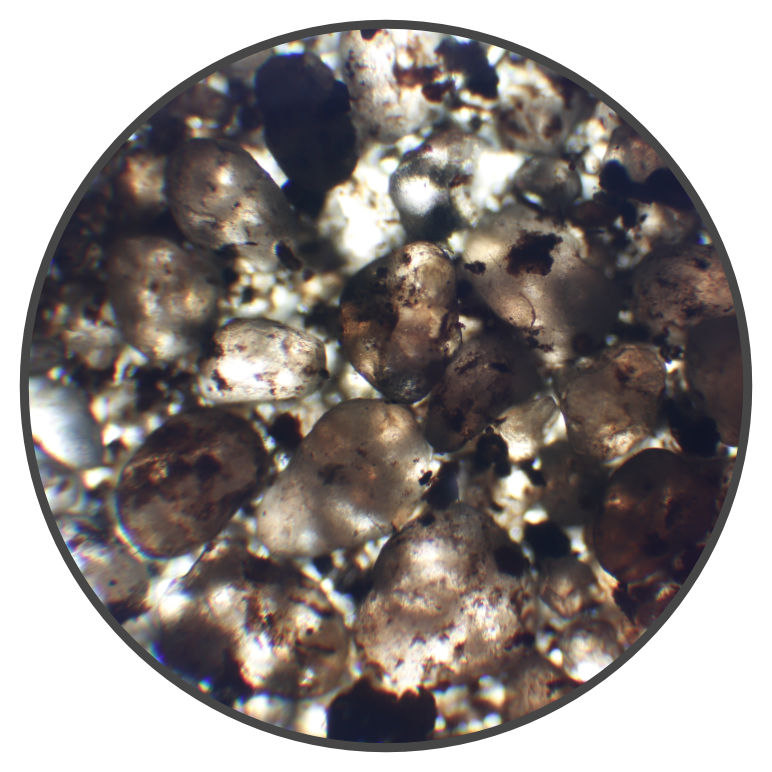Soil is a natural nutrient environment for plants, diversified in terms of physicochemical and biological properties, the composition of which depends on the type of rock that forms the substrate and undergoes soil-forming processes (physical and chemical), the amount of humus and the diversity of organisms living in it. It consists of three phases: solid (mineral, organic and mineral-organic parts), liquid (soil solution) and gas. In the most fertile soils, the optimal quantitative share of the individual phases is 40%, 30%, 30% respectively. All of them play a specific role in supplying plants with mineral nutrients.
A soil horizon is an organic, mineral or organic-mineral part of a soil profile, approximately parallel to the soil surface, distinguished from adjacent horizons by, among other things, relatively uniform color, consistency, grain size, chemical composition, and the amount and quality of organic matter. The properties of a soil horizon are shaped primarily by soil-forming processes. Materials within or beneath a soil profile that exhibit characteristics and properties related to lithogenesis are referred to as soil levels.
On the surface of all types of soils covered with permanent vegetation, there is an organic horizon containing fresh or partially decomposed organic matter. Beneath it is a humus horizon, taking on a colour from black, through dark grey, to brown, the thickness of which can be from several to several dozen centimetres. The arrangement and characteristics of the horizons lying below depend directly on the type of soil-forming process. In conditions of intensive percolation of rainwater, especially acidified, a light grey, sometimes white, leaching horizon is formed, also called an eluvial horizon, from which chemical compounds (including iron, aluminium, manganese, calcium, magnesium and other compounds), small mineral grains, humus substances and clay substances are removed. Beneath it is a rusty-brown, sometimes with visible stains and streaks, enrichment horizon, also called a leaching or illuvial horizon, in which substances washed out from the upper horizons or released as a result of chemical weathering of minerals are collected. In conditions of high soil moisture, a characteristic greenish-blue gley horizon is formed, in which intensive reduction processes occur. In organic soils, a muck horizon and a marsh horizon are additionally distinguished in this place, with varying degrees of decomposition of organic remains. The weathered rock lying in the lower part of the soil profile, not subject to soil-forming processes, forms the parent rock horizon, after which in organic soils there is a non-solid mineral substrate. The solid or cracked compact rock lying in the substrate forms the underlying rock horizon.
There are five types of zonal soils: podsols, lessives, brown proper, acidic brown and chernozems, and six types of azonal soils: black earths, alluvial soils, marshy soils, rendzinas, initial mountain soils and anthropogenic soils. Almost 80% of Poland’s surface is covered by brown, podsols and lessives. They are common in lowlands and lake districts. They are slightly less common in the uplands and mountains, especially podsols. In terms of agricultural usefulness, the most valuable of them are brown soils.

Elemental composition
The elemental composition of the soil can be divided into those necessary for the proper development of plants:
- Microelements: boron, copper, zinc, manganese, iron, molybdenum, silicon,aluminum, chlorine.
- Macroelements: potassium, sodium, calcium, magnesium, carbon, nitrogen, phosphorus, oxygen, sulfur, hydrogen.
Microelements occur in the soil in the form of humus and minerals of various chemical compositions, such as CuFeS2 (chalcopyrite) or MoS2 (molybdenite).
Soil richness
Soil richness is one of the factors that influences soil fertility. This is the total content of plant-available, assimilable forms of macro- and microelements, as well as humus and organic remains found in the soil, in relation to specific species and varieties or plant communities.
Two types of soil richness can be distinguished:
- Natural richness (in natural soils) in which nutrient resources have been created without human intervention.
- Agrotechnical richness (artificial, anthropogenic) includes both natural richness and that produced with human participation through the use of agrotechnical treatments (liming, mineral and organic fertilization).
Knowledge of the richness of the arable land, unfortunately often neglected in practice, is the basis for rational and in many cases also economical fertilization. It may turn out that the quantities and doses of fertilizers you use exceed the nutritional requirements of your plants.
Soil acidification
For several decades, one of the main problems of Polish agriculture has been soil acidification. According to the soil fertility index, acidification limits agricultural production to the greatest extent. Soil reaction (pH) is a fundamental factor influencing the effective use of nutrients by plants. It has been proven that soil with a pH in the range of 5.0-7.0 is the richest source of minerals in terms of quality and quantity, and is the largest pool of mineral nutrients available to plants in terms of quantity and quality.
The effects of soil acidification, which are the result of the processes of accumulation and neutralization of protons in this environment, are most often considered in a very simplified approach, taking into account only production losses in agriculture. The negative effects caused by soil acidification, on the other hand, concern not only cultivated fields, but also adjacent ecosystems, aquatic ecosystems, the atmosphere and a number of life processes of cultivated plants, including, above all, the reduction of the length of their root system. Disruption of the root system growth deep into the soil profile limits the plant’s ability to use local water reserves and mobile mineral components contained in it, such as nitrates, and at the same time reduces the uptake of low-mobility components from the soil, such as potassium and phosphorus, which condition the use of the nitrogen taken up by the plant. Additionally, it causes increased leaching of nitrates, chlorides and sulphates, as well as the inability to absorb cations, mainly calcium and magnesium, in the amount necessary for proper nitrogen uptake and regulation of its economy. The reduction of the root system is spatial in nature, leading to plant dysfunction throughout the soil profile. The agricultural method of controlling the excess of cations acidifying arable soils is liming. This procedure should be carried out in such a way as to eliminate aluminum toxicity, optimize the absorption of phosphorus and alkaline cations (K, Ca, Mg), provided that the absorption of micronutrients is maintained. Lime fertilizers have a completely different role to play than nitrogen, phosphorus and potassium fertilizers. The need to liming soils results from taking care of the appropriate lumpy soil structure, aeration, proper pH and availability of mineral components for plants.

Nutrients
Plant nutrients occur in the soil in various forms and quantities. In terms of plant nutrition, the most important group are their assimilable forms. From an agricultural point of view, the most important macroelements that have the greatest impact on the quality and height of crops include, in addition to nitrogen, phosphorus, potassium and magnesium. After determining the soil pH, the next, equally important step is to analyze the content of assimilable forms of these elements, which will allow for the assessment of the soil’s richness and fertility, and thus the implementation of rational fertilization with the elements that are lacking.
Mineral fertilizers should be applied in such quantities and in such a way as to provide the plants cultivated with the optimum amount of nutrients at a given time, without posing a threat to the natural environment, while generating savings and the greatest possible effect. The lack of information on the chemical and physicochemical properties of the soil leads, on the one hand, to unnecessary, excessive mineral fertilization, which is associated with additional costs, and on the other hand to the depletion of soils of basic nutrients. In view of the above, the use of fertilization without knowledge of the soil’s abundance in available nutrients is considered unjustified.
Nitrogen
The basic mineral element, which has a decisive significance in the intensification of plant production, is nitrogen. It is the most yield-forming macroelement in the cultivation of all plants. Plants react much more clearly to a deficiency or excess of this element in the growth environment than to soil resources of other nutrients.
Nitrogen is needed by plants as a building material for proteins, and is also a component of vitamins, nucleotides, nucleic acids, alkaloids, and chlorophyll. It stimulates the growth of above-ground parts of plants, giving them an intense green color, and regulates the balance of potassium, phosphorus, and other nutrients. Insufficient nitrogen causes stunting of plants, yellowing and falling of leaves, and limitation and weakening of the development of the root system. This element introduced into the soil with mineral fertilizers or foliarly quickly restores a healthy appearance to plants by improving physiological functions. However, there is a danger of over-fertilization with nitrogen, which causes excessive plant growth, susceptibility to lodging and diseases, delayed ripening, and a deterioration of their biological value due to nitrogen accumulation and an unfavorable change in the composition of nitrogen compounds in the plant, resulting in a relatively low grain yield.
Nitrogen is supplied to the soil both through mineral and organic fertilization, manure, plant residues, and also naturally, as a result of biological binding of elemental nitrogen by symbiotic (Rhizobium) and free-living bacteria (Azotobacter, Arthrobacter, Beijerinckia, Derxia and Clostridium), which are capable of breaking the triple bond of the nitrogen molecule, in the presence of a catalyst, which is the enzyme nitrogenase common to the mentioned microorganisms, and also due to the occurrence of its mineral forms in atmospheric precipitation. The nitrogen molecule is extremely durable and chemically inactive, therefore its breaking requires a very large share of energy, the source of which in this process is ATP. In the arable layer of Polish cultivated soils, the total amount of nitrogen is from 0.02 to 0.35% of the elemental composition of the soil. Most soil nitrogen, about 95-99%, is found in the form of organic nitrogen compounds, mainly in organic matter. Nitrogen in the form of organic compounds is contained in humus, undecomposed organic matter and soil organisms. Hence, the largest amount of it in mineral soils is found in humus horizons of soils and decreases towards the soil profile. Mineral forms constitute 1 to 5% of the total nitrogen content in soil. Among them, the most reduced forms can be distinguished, such as ammonia (NH3) and ammonium ions (NH4+), molecular nitrogen (N2), which is an intermediate form, and the most oxidized forms, nitrites (NO2–) and nitrates (NO3–). Plants can only use nitrogen in the form of NH4+ and NO3– ions, contained in basic mineral compounds, such as ammonium and nitrate salts, which are substrates or products of many nitrogen transformations in the soil, making up the so-called small and large nitrogen cycle in nature. Assuming that the mass of soil per 1 ha is 3 million kg, it contains from 600 to 10,500 kg of total nitrogen, of which only 1-2%, or from 6 to 210 kg, are mineral forms taken up by plants. Despite the small share of mineral nitrogen in the total content of this element in the soil, it plays the most important role in plant nutrition.
The content of mineral nitrogen in the soil is influenced not only by meteorological conditions and agricultural activity of man, but above all by the properties of the soil itself. The content of this form of nitrogen depends largely on the content of organic matter and the course of its mineralization, as well as on the granulometric composition and the complex of agricultural suitability of the soil.
Soils in every climate tend to achieve the so-called normal or balanced nitrogen content, using normal cultivation methods and fertilization, and any attempt to increase its content above this normal level is associated with unnecessary losses of this component through leaching, oxidation and erosion. Therefore, knowing the level of available forms of soil nitrogen is a basic condition for determining the correct dose of fertilization with this component, as well as minimizing production costs, while limiting the generation of environmental pollution, because excessive nitrogen doses lead to the loss of the component, in gaseous form to the atmosphere and in the form of nitrates to groundwater and surface water, which is a financial loss and creates an ecological threat.

Elemental balance
Nitrogen is absorbed by plants in large quantities, but it should be remembered that fertilization with this element alone does not guarantee a large, high-quality yield. To obtain the expected result, it is necessary to provide the crop with a balance of all necessary, interacting nutrients, and above all those that increase the use of nitrogen. The element that interacts most strongly with nitrogen is potassium. Nitrogen contributes to effective yield growth, automatically increasing the plant’s demand for potassium. Potassium deficiency at a given moment drastically reduces the plant’s ability to absorb nitrogen and has a negative impact on its yield potential. Proper supply of potassium to plants promotes their absorption of nitrogen. The above-mentioned components act antagonistically to magnesium ions, which is why its quantitative balance in the soil should be taken care of. Magnesium deficiency also affects the quality of plant products through changes in nitrogen management. Sulfur is also an important macroelement, the correct amounts of which in the soil affect more effective nitrogen absorption and reduce the leaching of nitrates into groundwater. Moreover, complex functions in the use of nitrogen are performed by microelements, the specific action of which in each phase of plant growth cannot be replaced by another component. Excess nitrogen, with a deficiency of other nutrients and vice versa, constitute a significant economic problem, as well as a growing ecological problem. The primary role in plant metabolism is played not by the absolute content, but by the optimal adjustment of the proportions of individual nutrients, macro- and microelements.


